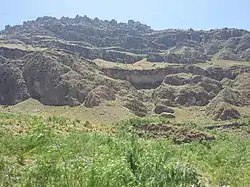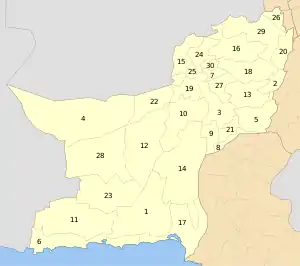Harnai District
Harnai (Balochi: ہرنائ, Pashto: هرنای, Urdu: ضلع ہرنائی) is a district in the north-east of the Balochistan province of Pakistan. Harnai is the principal town of this district and serves as its capital.
Harnai District
ضلع ہرنائی | |
|---|---|
 Mountains in Harnai | |
 Map of Balochistan with Harnai District highlighted | |
| Coordinates: 30.105447°N 67.939861°E | |
| Country | |
| Province | |
| Division | Sibi |
| Headquarters | Harnai |
| Government | |
| • Type | District Administration |
| • Deputy Commissioner | N/A |
| • District Police Officer | N/A |
| • District Health Officer | N/A |
| Area | |
| • Total | 2,492 km2 (962 sq mi) |
| Population (2017)[1] | |
| • Total | 97,052 |
| • Density | 39/km2 (100/sq mi) |
| Time zone | UTC+5 (PST) |
The predominant first language is Pashto. Wanetsi, or Tarino, a unique and archaic dialect of Pashto, is spoken in the district.[2]
History
The name Harnai refers to an influential Hindu personality, Harnam Das, supposed founder of Harnai town, the capital of Harnai District. The town is quite close to Loralai, Ziarat, Sibi, and Quetta. Harnai is surrounded by imposing hills on all sides. The encircling hill ranges have the resounding names of 'Khalifat' and 'Zarghun'. Harnai proper has a population of about 200,000. The majority of the population of Harnai are Tareens and they mostly speak a unique dialect, or language, Tarino (Wanetsi), which is quite different from the Pushto spoken in other parts of Baluchistan and NWFP provinces, and is probably a mixture of Pushto, Urdu and other languages developed as a 'lingua franca' sometime during the 18th and 19th centuries, when a variety of people of different ethnic origins lived here. There seems to be no earlier historical record or trace of it.
Until 2007 Harnai had been a tehsil of Sibi District, in August the Balochistan Government announced the Harnai district would be created by splitting the Sibi district and forming the new district from Harnai and Shahrag tehsils and the sub-tehsil of Khost.
Geography and climate
Harnai is surrounded by mountainous ranges. The minimum and maximum winter temperature of the area is −2˚C to 20˚C. The summer is extreme in the area and the minimum and maximum temperature fall between 20˚C to 48˚C. Harnai has a fertile rainy season during monsoon time. In general, Harnai has pleasant weather in the winter season. Harnai is one of the most beautiful cities of the Balochistan Province with plenty of water available in the streams. It is the only area of the production of fresh vegetables and fruits with fresh and clean water in the whole of Balochistan.
Demographics
At the time of the 2017 census the district had 16,994 households and a population of 97,052. Harnai had a sex ratio of 867 females per 1000 males and a literacy rate of 36.24% - 49.86% for males and 20.28% for females. 24,562 (25.31%) lived in urban areas. 32,705 (33.70%) were under 10 years of age. 611 (0.63%) people in the district were from religious minorities.[1]
At the time of the 2017 census, 83.48% of the population spoke Pashto, 12.65% Balochi and 1.37% Sindhi as their first language.[1]
Villages
2Sazoo 3.Sunari 4.spentangi 5.shenkhuch 6.kilimerza 7.kachari 8.pir 9.dub 10.kurazawara 11'Gochina 12 kili Ghadyan
References
- "District Wise Results / Tables (Census - 2017)". www.pbscensus.gov.pk. Pakistan Bureau of Statistics.
- Hallberg, Daniel G. 1992. Pashto, Waneci, Ormuri. Sociolinguistic Survey of Northern Pakistan, 4.
Bibliography
- 1998 District census report of Sibi. Census publication. Vol. 17. Islamabad: Population Census Organization, Statistics Division, Government of Pakistan. 1999.
External links
- Harnai District at www.balochistan.gov.pk
- Harnai District Development Profile 2011 Archived 2017-10-26 at the Wayback Machine
- Harnai at
